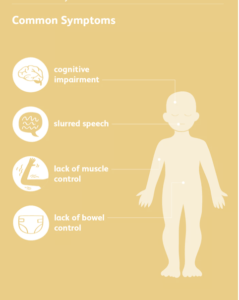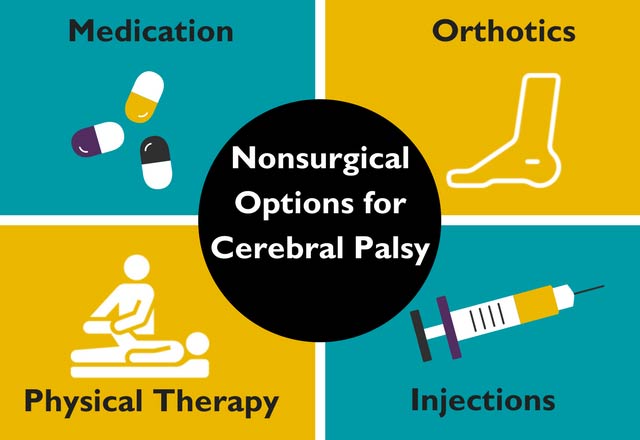Cerebral Palsy diagnosis and treatment
Cerebral palsy is not a single disorder, but a term for any child with development delay, motor delay- delay in sitting, delay in standing, speech delay or intellectual disability. However, the concept is incurrent
In simple terms, cerebral palsy (CP) is a disorder in which there is improper control of muscle movement in different parts of the body.
In a child with cerebral palsy, the brain impulse is distorted leading to poor co-ordination, stiffness, tightness, toe-walking
Cerebral palsy is a disorder in there is poor control physical movements of the body. Cerebral palsy is caused by brain injury during early childhood and infancy. The timing of the brain injury is critical. Brain damage occurs maximally during pregnancy; childbirth, labour, delivery process or immediately after childbirth. After a child is 1 month old, chances of brain injury to cause cerebral palsy is less. The cause of brain injury to new born include
Oxygen Deprivation: A number of complications during pregnancy (e.g., infection of mother, membrane rupture, umbilical cord problems) can reduce the supply of oxygen to the baby. Complications during labour and delivery can also cause oxygen deprivation. Oxygen deprivation leads to death of brain cells
Developmental Abnormalities: cerebral palsy can also result when there is poor development of brain during pregnancy. This can be caused by genetic disorders or infection, fever, or injuries, hypoglycaemia
- Childbirth Trauma: cerebral palsy is commonly caused by injuries during labour and delivery. Obstetrical forceps delivery or vacuum extractors can cause oxygen deprivation and brain injury
HIE – hypoxic ischemic encephalopathy
Perinatal asphyxia or delayed cry after birth
Infection of new born like EONS, LONS, sepsis, meningitis, pneumonia
High jaundice, needing DVET double volume exchange transfusion
Low sugar of new born, neonatal hypoglycaemia
Neonatal seizures, jerks, fits
Prematurity
PVL periventricular leukomalacia
No. Cerebral palsy is a not a genetic disorder. Cerebral palsy is due to injury to the brain during pregnancy or childbirth. It is not triggered by the parent’s DNA. In very rare situation, when there are two or more children with family, unexplained deaths of previous children, marriage between relatives, fluctuating neurological course should prompt evaluation for inherited and metabolic disorders
Cerebral palsy is a disorder with wide variety of symptoms.
The common symptoms of cerebral palsy
Delay in sitting and standing
Delay in head holding
Delay in speech
Vision problems like squint, poor eye contact
Epilepsy, seizures, mirgi
Development delay, intellectual disability and mental retardation
Other associated symptoms include
Poor swallowing, recurrent regurgitation of feed, recurrent vomiting
Recurrent fever, recurrent ear infection and pneumonia
Poor weight gain, poor growth
The severity varies in every child. Some children can have only minor disability in walking with normal intelligence
Some children have only seizures with no other problems
Some children have only small head with no problems
Different permutation of above-mentioned symptoms can be used with different severity
There are several different subtypes of cerebral palsy each of which comes with its own unique set of symptoms and affects different parts of the body. Some degree of physical abnormality will typically be noticeable in a child with cerebral palsy.
No. Cerebral palsy is not considered a progressive disorder, which means that it will not continue to get worse over time. It will improve slowly. The improvement is variable. The speed of improvement is variable. The extent to which child will improve is unpredictable.
Cerebral palsy is due to brain injury during birth. Brain injury is a onetime event with no further damage. The degree of improvement depends on amount of brain not injured. In fact, with effective therapy and treatment, the symptoms of cerebral palsy can improve with time
Cerebral palsy itself is not a potentially life-threatening disorder. Risk of dying is slightly higher for children with cerebral palsy with difficulty chewing and swallowing which predisposes them for choking, aspiration pneumonia. Children with CP are at higher risk for seizures. Though the risk of death from seizures is low, the life time risk of seizure recurrence is high
Currently, there is no role of cure by stem cells
Sadly, there is currently no “cure” to treat children with cerebral palsy. Cerebral palsy is caused by permanent brain damage, so deficits often remain. However, a treatment options are available which will improve quality of life for children with cerebral palsy. Absence of cure doesn’t mean absence of improvement. With good quality physical therapy, physiotherapy, occupation therapy, nutrition therapy, control of seizures
Tests for different function of body need to be done
These include
MRI brain to see for extent of brain damage
EEG test if child has seizures
BERA test for hearing
Test to evaluate general health like haemoglobin, calcium, Vitamin D and vitamin B12
Opthal evaluation for squint
ENT and gastroenterology evaluation for any feeding problems
Physiotherapy evaluation
Paediatric Neurologist- 1-2 monthly
Ophthalmologist- 3-6 monthly
Physiotherapist- 1-4 times a month
Occupation therapist- 1-4 times a month
ENT doctor- once initially
Paediatric Orthopaedic doctor if advised
I am not sure of the role. They are left to the decision of the parents. However, the above-mentioned doctors like paediatric neurologist and physiotherapist need to be shown regularly
Supplements like Iron, multivitamin, calcium is commonly given. Other supplements include piracetam, DHA, omega 6 fatty acid, carnosine, dimethylglycine. However, the role of such supplements is unknown. Fish liver oil is a used by many parents
All vaccines can be given and should be given, Optional vaccines like Hemophilus, pneumococcal and flu vaccine can be considered after discussing with parents
Does a child with cerebral palsy have risk for seizures?
Child with cerebral palsy have higher risk of seizures compared to other children. Even if the EEG is normal and child suffers a seizure, anti-seizure medication should be given. The seizure frequency varies in different children
Certain types of children with cerebral palsy like diplegic cerebral palsy have very minimal impairment with very good intelligent. The only impairment they might have is difficulty in sport requiring quick activities. Because of risk of seizures, children with cerebral palsy should not engage in adventure sports

What Are the Primary Symptoms of Cerebral Palsy?

IS there cure of cerebral palsy?
What kind of test will have to be done?
/cerebral-palsy-diagnosis-5adf7246119fa800374ce4b4.png)
Is there any role of homeopathy or Ayurveda?

